Practical Analysis of BIM Tasks for Modular Construction Projects in South Korea
Abstract
1. Introduction
2. Research Methodology
- (1)
- In preliminary considerations, the BIM application is reviewed through previous studies. Then, the concept of the modular construction method and the current status of BIM in Korea are summarized.
- (2)
- Key activities and BIM tasks for modular projects are derived. The key activities are derived by dividing the off-site and on-site phases throughout the survey results of a 5-point Likert scale for experts as items above average. The BIM tasks are derived through literature review and interviews with experts in BIM and modular construction.
- (3)
- The relational matrix for key activities and BIM tasks is proposed. First, a BIM task that can be effective when applied to each key activity is selected. Second, BIM tasks assigned to key activities of the matrix are selected as BIM tasks being presented by more than half of the experts. Finally, the experts review the matrix and confirm it.
- (4)
- The relational matrix based on the BIM task index is proposed. The necessity and efficiency index of the BIM tasks assigned to each key activity are deduced by modular construction experts using a survey of 5-point Likert scales. Finally, the BIM utilization index (BIM UI) is presented. The practicality of the proposed matrix is evaluated and discussed through expert interviews.
3. Preliminary Considerations
3.1. Literature Review
3.2. Modular Construction in Korea
3.3. BIM Use in Korea
4. Key Activities and BIM Tasks for Modular Projects
4.1. Key Activities
4.2. BIM Tasks
4.3. Relational Matrix of Key Activities and BIM Tasks
5. Relational Matrix Based on the BIM Task Index
5.1. Survey Overview
5.2. Results
6. Discussion
7. Conclusions
Author Contributions
Funding
Acknowledgments
Conflicts of Interest
References
- Abanda, F.H.; Tah, J.H.M.; Cheung, F.K.T. BIM in off-site manufacturing for buildings. J. Build. Eng. 2017, 14, 89–102. [Google Scholar] [CrossRef]
- Yin, X.; Liu, H.; Chen, Y.; Al-Hussein, M. Building information modelling for off-site construction: Review and future directions. Autom. Constr. 2019, 101, 72–91. [Google Scholar] [CrossRef]
- Sabet, P.G.P.; Chong, H.Y. Interactions between building information modelling and off-site manufacturing for productivity improvement. Int. J. Manag. Proj. Bus. 2019, 13, 233–255. [Google Scholar] [CrossRef]
- Farmer, M. The Farmer Nstruction Labour Model. Construction Leadership Council, October 2016. Available online: https://www.constructionleadershipcouncil.co.uk/wp-content/uploads/2016/10/Farmer-Review.pdf (accessed on 5 August 2020).
- Ji, Y.B.; Qi, K.; Qi, Y.; Li, Y.; Li, H.X.; Lei, Z.; Liu, Y. BIM-based life-cycle environmental assessment of prefabricated buildings. Eng. Constr. Archit. Manag. 2020. Available online: https://scihub.wikicn.top/10.1108/ECAM-01-2020-0017 (accessed on 5 August 2020).
- Hammad, A.W.; Akbarnezhad, A.; Wu, P.; Wang, X.; Haddad, A. Building information modelling-based framework to contrast conventional and modular construction methods through selected sustainability factors. J. Clean. Prod. 2019, 228, 1264–1281. [Google Scholar] [CrossRef]
- Jiang, Y.S.; Zhao, D.; Wang, D.; Xing, Y.D. Sustainable performance of buildings through modular prefabrication in the construction phase: A comparative study. Sustainability 2019, 11, 5658. [Google Scholar] [CrossRef]
- Chong, H.Y.; Lee, C.Y.; Wang, X.Y. A mixed review of the adoption of building information modelling (BIM) for sustainability. J. Clean. Prod. 2017, 142, 4114–4126. [Google Scholar] [CrossRef]
- Lu, N.; Korman, T. Implementation of Building Information Modeling (BIM) in Modular Construction: Benefits and Challenges. In Proceedings of the Construction Research Congress 2010: Innovation for Reshaping Construction Practice, Banff, Alberta, AB, Canada, 8–10 May 2010; pp. 1136–1145. Available online: https://scihub.wikicn.top/10.1061/41109(373)114 (accessed on 2 June 2020).
- Nawari, N.O. BIM standard in off-site construction. J. Archit. Eng. 2012, 2, 107–113. [Google Scholar] [CrossRef]
- Lee, M. Analysis of BIM utilization for on-site construction planning in modular construction project. J. Korea Inst. Build. Constr. 2019, 19, 263–272. [Google Scholar] [CrossRef]
- Sacks, R.; Eastman, C.; Lee, G.; Paul Teicholz, P. BIM Handbook: A Guide to Building Information Modeling for Owners, Managers, Designers, Engineers and Contractors, 3rd ed.; John Wiley & Sons: Somerset, NJ, USA, 2011. [Google Scholar]
- Ezcan, V.; Isikdag, U.; Goulding, J.S. BIM and Off-Site Manufacturing: Recent Research and Opportunities. In Proceedings of the 19th CIB World Building Congress, Brisbane, Australia, 5–9 May 2013; Available online: https://www.irbnet.de/daten/iconda/CIB_DC27218.pdf (accessed on 5 August 2020).
- Lee, J.; Kim, J. BIM-based 4D simulation to improve module manufacturing productivity for sustainable building projects. Sustainability 2017, 9, 426. [Google Scholar] [CrossRef]
- Alwisy, A.; Al-Hussein, M. Automation in Drafting and Design for Modular Construction Manufacturing Utilizing 2D CAD and Parametric Modeling. In Proceedings of the International Conference on Computing in Civil and Building Engineering, Nottingham, UK, 30 June–2 July 2010; Available online: https://doi.org/10.1061/(ASCE)CP.1943-5487.0000246 (accessed on 2 May 2020).
- Moghadam, M.; Alwisy, A.; Al-Hussein, M. Integrated BIM/Lean Base Production Line Schedule Model for Modular Construction Manufacturing. In Proceedings of the Construction Research Congress 2012: Construction Challenges in a Flat World, West Lafayette, OH, USA, 21–23 May 2012. [Google Scholar]
- Suh, B.G.; Yun, S.H. BIM based optimize method of finish material placing for modular unit. J. Archit. Inst. Korea Struct. Constr. 2014, 3, 97–104. [Google Scholar] [CrossRef]
- Han, S.H.; Al-Hussein, M.; Al-Jibouri, S.; Yu, H. Automated post-simulation visualization of modular building production assembly line. Autom. Constr. 2012, 21, 229–236. [Google Scholar] [CrossRef]
- Han, S.H. BIM-Based Motion Planning of Mobile Crane Operation in Modular-Based Heavy Construction Sites. Ph.D. Thesis, University of Alberta, Edmonton, AB, Canada, 2014. [Google Scholar]
- Han, S.H.; Hasan, S.; Bouferguène, A.; Al-Hussein, M.; Kosa, J. Utilization of 3D visualization of mobile crane operations for modular construction on-site assembly. J. Manag. Eng. 2015, 5, 04014080. [Google Scholar] [CrossRef]
- Korman, T.M.; Lu, N. Innovation and Improvements of Mechanical, Electrical, and Plumbing Systems for Modular Construction Using Building Information Modeling. In Proceedings of the AEI 2011: Building Integration Solutions, California, CA, USA, 30 March–2 April 2011. [Google Scholar]
- Lee, C.J.; Lim, S.H. A study on development of BIM library for unit modular housing-focused on small-sized urban-life-housing. J. Korean Hous. 2012, 23, 11–20. [Google Scholar] [CrossRef][Green Version]
- Solnosky, R.L.; Memari, A.M.; Ramaji, I.J. Structural BIM Processes for Modular Multi-Story Buildings in Design and Construction. In Proceedings of the 2nd Residential Building Design & Construction Conference, University Park, Pennsylvania, PA, USA, 19–20 February 2014. [Google Scholar]
- Samarasinghe, T.; Mendis, P.; Ngo, T.; Fernando, W.J.B.S. BIM Software Framework for Prefabricated Construction: Case Study Demonstrating BIM Implementation on a Modular House. In Proceedings of the 6th International Conference on Structural Engineering and Construction Management, Kandy, Sri Lanka, 11–13 December 2015. [Google Scholar]
- Lee, U.K.; Lee, M. An analysis of BIM uptake in each phase of modular construction projects in Korea. J. Reg. Assoc. Archit. Inst. Korea 2019, 5, 133–140. [Google Scholar]
- Yoon, S.H.; Choi, J.W.; Cho, S.Y. A design and development of a temporary housing system based on BIM in advance of disasters. J. Korean Hous. Assoc. 2013, 24, 69–78. [Google Scholar] [CrossRef]
- Zhao, H.R.; Liu, H.X.; Al-Hussein, M. Automation of Quantity Take-off for Modular Construction. In Proceedings of the Modular and Offsite Construction (MOC), Alberta, AB, Canada, 19–21May 2015. [Google Scholar]
- Computer Integrated Construction Research Group. Building Information Modeling Project Execution Planning Guide Version-2.1; Pennsylvania State University: University Park, PA, USA, 2011. [Google Scholar]
- Shin, H.K.; Ahn, Y.H. Decision model of construction errors management based on modular method construction process. Korea Inst. Constr. Eng. Manag. 2017, 18, 98–108. [Google Scholar] [CrossRef]
- Field, A. Discovering Statistics Using SPSS, 3rd ed.; Sage: London, UK, 2013. [Google Scholar]
- Basic Guidelines of the Facility Business BIM Application v2.0. Public Procurement Service, Korea, 2019. Available online: http://www.pps.go.kr/bbs/selectBoard.do?boardSeqNo=3752&boardId=PPS089 (accessed on 2 May 2020).
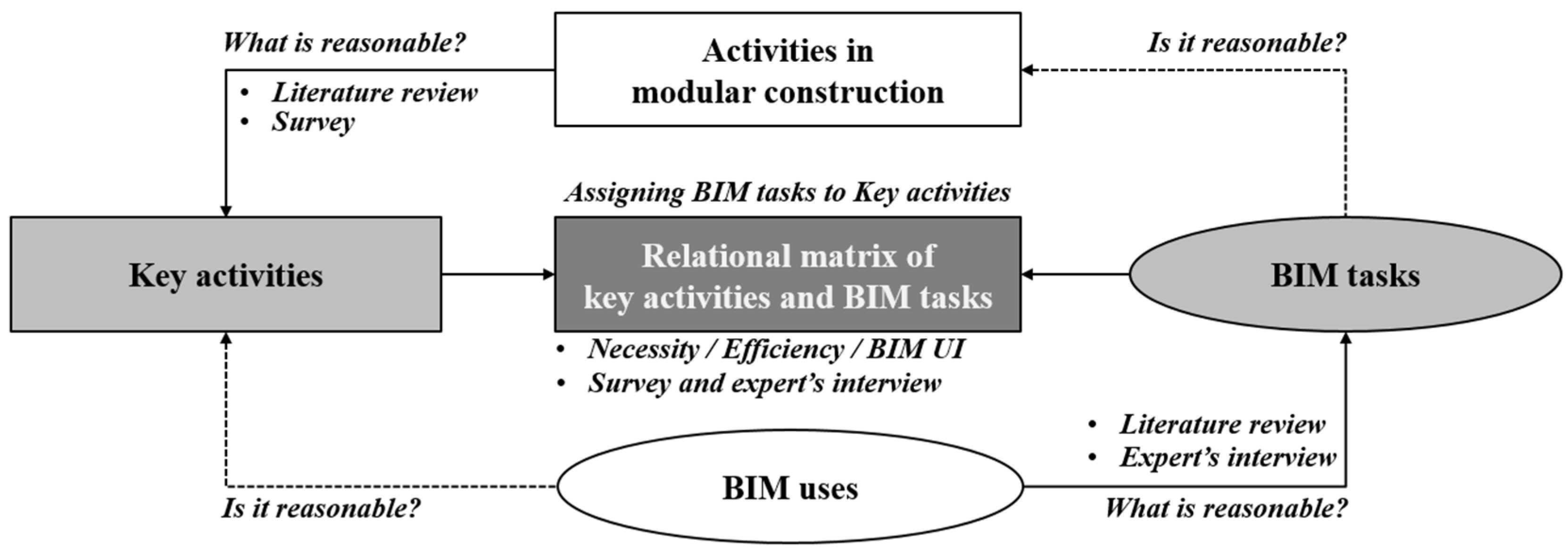
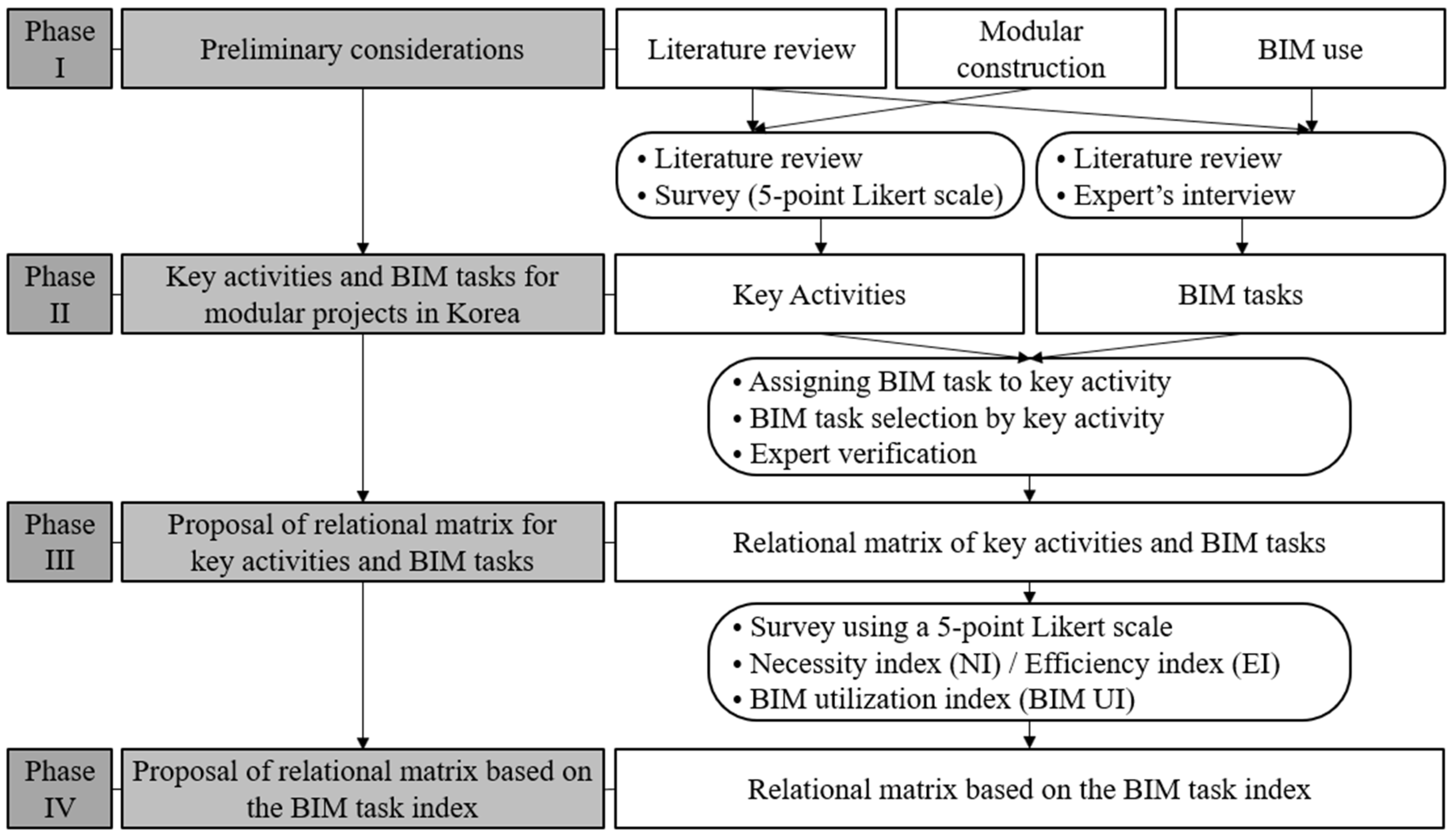

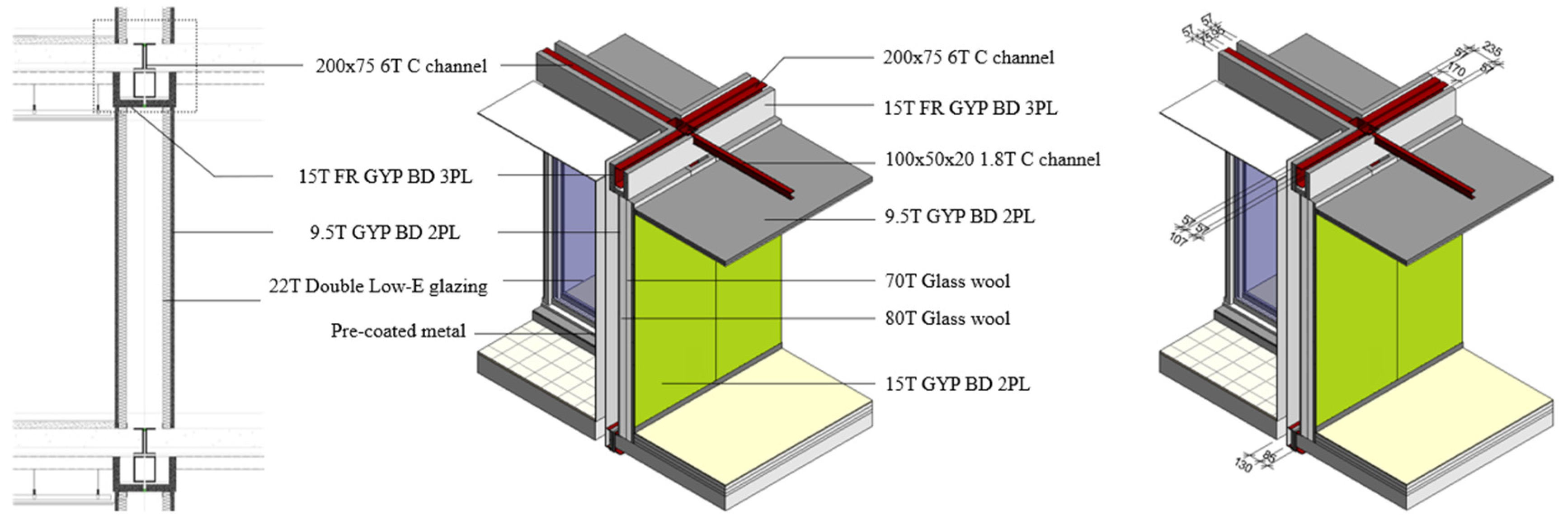
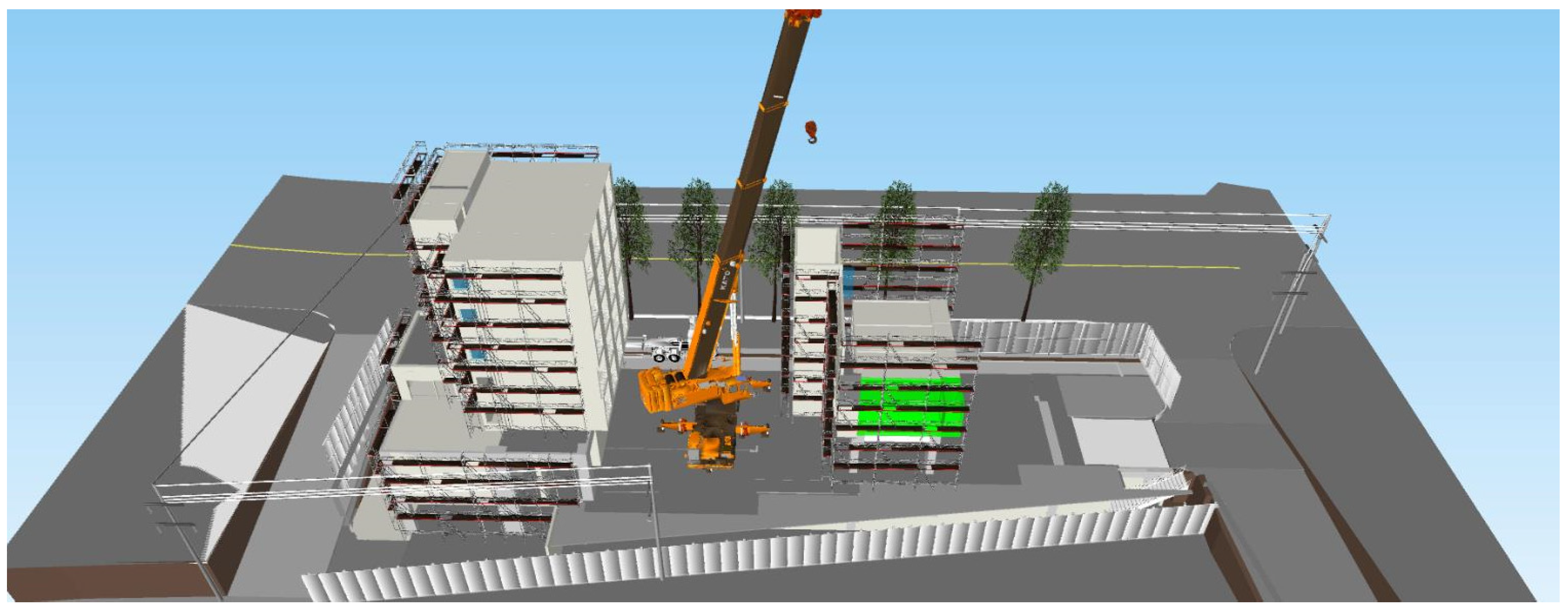
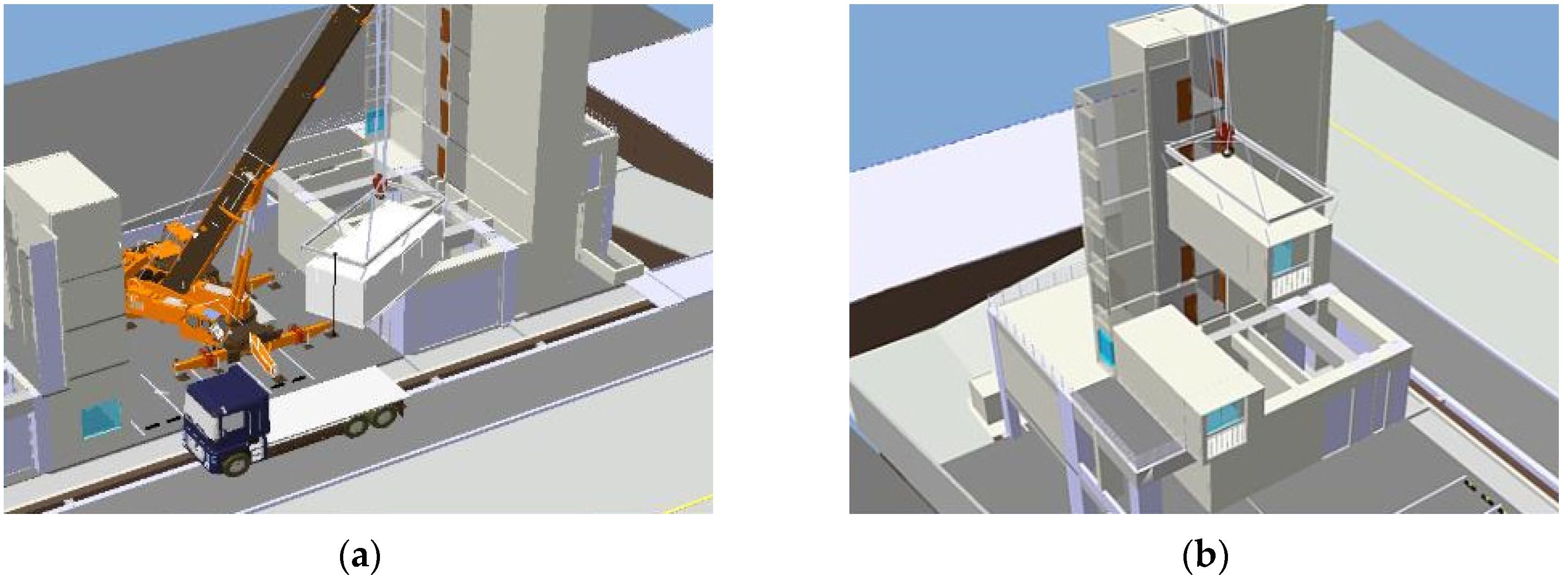
| Phase | Reference | Detailed Content |
|---|---|---|
| Off-site | Alwisy and Al-Hussein (2010) [15] | Methodology of parametric modeling |
| Moghadam et al. (2012) [16] | BIM-based schedule model for off-site manufacturing | |
| Ezcan et al. (2013) [13] | Research review of BIM and off-site manufacturing | |
| Suh and Yun (2014) [17] | Analyses of BIM-based finish material placing | |
| Abanda et al. (2017) [1] | Analyses of BIM impact for off-site manufacturing | |
| Lee (2017) [14] | Development of BIM-based 4D simulation framework | |
| On-site | Han et al. (2012) [18] | Automated post-simulation visualization |
| Han (2014) [19] | BIM-based motion planning of mobile crane | |
| Han et al. (2015) [20] | BIM-based 3D visualization of mobile crane operations | |
| Lee (2019) [11] | BIM utilization for construction planning | |
| Overall | Lu and Korman (2010) [9] | Analyses of BIM impact on the design phase |
| Korman and Lu (2011) [21] | Analyses of BIM implementation for MEP | |
| Nawari (2012) [10] | Analyses of the BIM process | |
| Lee and Lim (2012) [22] | Review of the BIM modeling process | |
| Solnosky et al. (2014) [23] | Analyses of the BIM process and tasks | |
| Samarasinghe et al. (2015) [24] | Analyses of BIM implementation on the design phase | |
| Lee and Lee (2019) [25] | BIM uptake for on/off-site construction |
| Phase | Code | Classification | Mean | Standard Deviation |
|---|---|---|---|---|
| Off-site | C1 | Schedule management of overall off-site fabrication | 4.833 | 0.389 |
| C2 | Planning and management of the module fabrication process | 4.083 | 0.515 | |
| C3 | Quality management of the joint assembly | 4.333 | 0.492 | |
| C4 | Schedule management of module structure fabrication | 4.417 | 0.515 | |
| C5 | Quality management of metal/door/window/siding/roof/finishing work | 4.667 | 0.492 | |
| C6 | Quality management of mechanical/electrical/plumbing work | 4.417 | 0.515 | |
| On-site | C7 | Schedule management of overall on-site construction | 4.750 | 0.452 |
| C8 | Planning and management of lifting work | 4.667 | 0.651 | |
| C9 | Quality management of module-to-module joining work | 4.250 | 0.622 | |
| C10 | Quality management of metal/door/window/siding/roof/finishing work | 4.417 | 0.669 | |
| C11 | Quality management of mechanical/electrical/plumbing work | 4.583 | 0.515 |
| Code | BIM Task | Reference | ||||
|---|---|---|---|---|---|---|
| BIM Guide | PPS Guide | Literature Review | BIM Experts | Modular Construction Experts | ||
| T1 | Detailed 3D modeling for critical joints | √ | ||||
| T2 | 3D shop drawings | √ | √ | |||
| T3 | Creation of a 3D model for site layout and conditions | √ | √ | √ | ||
| T4 | Creation of a 4D simulation model | √ | √ | |||
| T5 | Creation of a 4D sequence model for critical joints | √ | ||||
| T6 | Creation of a 4D model for the lifting plan | √ | √ | |||
| T7 | Integration of a 4D model with quantity take-off | √ | √ | √ | ||
| Classification | BIM Tasks | |||||||
|---|---|---|---|---|---|---|---|---|
| Phase | Key Activity | T1 | T2 | T3 | T4 | T5 | T6 | T7 |
| Off-site | C1 | √ | √ | |||||
| C2 | √ | √ | √ | √ | ||||
| C3 | √ | √ | √ | |||||
| C4 | √ | √ | √ | √ | ||||
| C5 | √ | √ | ||||||
| C6 | √ | √ | √ | |||||
| On-site | C7 | √ | √ | √ | √ | |||
| C8 | √ | √ | √ | |||||
| C9 | √ | √ | √ | |||||
| C10 | √ | √ | √ | |||||
| C11 | √ | √ | √ | √ | ||||
| Classification | BIM Tasks | ||||||||||||||||
|---|---|---|---|---|---|---|---|---|---|---|---|---|---|---|---|---|---|
| Phase | Key Activity | T1 | T2 | T3 | T4 | T5 | T6 | T7 | Total | ||||||||
| NI | EI | NI | EI | NI | EI | NI | EI | NI | EI | NI | EI | NI | EI | NI | EI | ||
| UI | UI | UI | UI | UI | UI | UI | UI | ||||||||||
| Off-site | C1 | 0.80 | 0.77 | 0.93 | 0.90 | 0.87 | 0.84 | ||||||||||
| 0.78 | 0.92 | 0.85 | |||||||||||||||
| C2 | 0.80 | 0.80 | 0.73 | 0.77 | 0.73 | 0.80 | 0.93 | 0.90 | 0.80 | 0.82 | |||||||
| 0.80 | 0.75 | 0.77 | 0.92 | 0.81 | |||||||||||||
| C3 | 0.80 | 0.83 | 0.93 | 0.97 | 0.70 | 0.67 | 0.81 | 0.82 | |||||||||
| 0.82 | 0.95 | 0.68 | 0.82 | ||||||||||||||
| C4 | 0.63 | 0.60 | 0.77 | 0.70 | 0.67 | 0.60 | 0.87 | 0.80 | 0.74 | 0.68 | |||||||
| 0.62 | 0.73 | 0.63 | 0.83 | 0.71 | |||||||||||||
| C5 | 0.83 | 0.77 | 0.60 | 0.53 | 0.72 | 0.65 | |||||||||||
| 0.80 | 0.57 | 0.68 | |||||||||||||||
| C6 | 0.83 | 0.80 | 0.90 | 0.87 | 0.67 | 0.67 | 0.80 | 0.78 | |||||||||
| 0.82 | 0.88 | 0.67 | 0.79 | ||||||||||||||
| Total | 0.78 | 0.76 | 0.92 | 0.92 | 0.74 | 0.73 | 0.68 | 0.65 | 0.91 | 0.87 | 0.81 | 0.79 | |||||
| 0.77 | 0.92 | 0.73 | 0.66 | 0.89 | 0.80 | ||||||||||||
| On-site | C7 | 0.60 | 0.60 | 0.83 | 0.80 | 0.77 | 0.77 | 0.87 | 0.83 | 0.77 | 0.75 | ||||||
| 0.60 | 0.82 | 0.77 | 0.85 | 0.76 | |||||||||||||
| C8 | 0.67 | 0.63 | 0.60 | 0.63 | 0.90 | 0.90 | 0.72 | 0.72 | |||||||||
| 0.65 | 0.62 | 0.90 | 0.72 | ||||||||||||||
| C9 | 0.93 | 0.93 | 0.63 | 0.63 | 0.63 | 0.63 | 0.73 | 0.73 | |||||||||
| 0.93 | 0.63 | 0.63 | 0.73 | ||||||||||||||
| C10 | 0.73 | 0.60 | 0.60 | 0.53 | 0.63 | 0.63 | 0.65 | 0.59 | |||||||||
| 0.67 | 0.57 | 0.63 | 0.62 | ||||||||||||||
| C11 | 0.77 | 0.73 | 0.83 | 0.80 | 0.57 | 0.53 | 0.60 | 0.63 | 0.69 | 0.67 | |||||||
| 0.75 | 0.82 | 0.55 | 0.62 | 0.68 | |||||||||||||
| Total | 0.81 | 0.76 | 0.83 | 0.80 | 0.63 | 0.62 | 0.67 | 0.66 | 0.61 | 0.60 | 0.73 | 0.73 | 0.87 | 0.83 | 0.74 | 0.71 | |
| 0.78 | 0.82 | 0.63 | 0.66 | 0.61 | 0.73 | 0.85 | 0.73 | ||||||||||
| Grand total | 0.80 | 0.76 | 0.88 | 0.86 | 0.63 | 0.62 | 0.70 | 0.69 | 0.64 | 0.63 | 0.73 | 0.73 | 0.89 | 0.85 | 0.75 | 0.73 | |
| 0.78 | 0.87 | 0.63 | 0.70 | 0.63 | 0.73 | 0.87 | 0.74 | ||||||||||
© 2020 by the authors. Licensee MDPI, Basel, Switzerland. This article is an open access article distributed under the terms and conditions of the Creative Commons Attribution (CC BY) license (http://creativecommons.org/licenses/by/4.0/).
Share and Cite
Lee, M.; Lee, D.; Kim, T.; Lee, U.-K. Practical Analysis of BIM Tasks for Modular Construction Projects in South Korea. Sustainability 2020, 12, 6900. https://doi.org/10.3390/su12176900
Lee M, Lee D, Kim T, Lee U-K. Practical Analysis of BIM Tasks for Modular Construction Projects in South Korea. Sustainability. 2020; 12(17):6900. https://doi.org/10.3390/su12176900
Chicago/Turabian StyleLee, Myungdo, Dongmin Lee, Taehoon Kim, and Ung-Kyun Lee. 2020. "Practical Analysis of BIM Tasks for Modular Construction Projects in South Korea" Sustainability 12, no. 17: 6900. https://doi.org/10.3390/su12176900
APA StyleLee, M., Lee, D., Kim, T., & Lee, U.-K. (2020). Practical Analysis of BIM Tasks for Modular Construction Projects in South Korea. Sustainability, 12(17), 6900. https://doi.org/10.3390/su12176900






